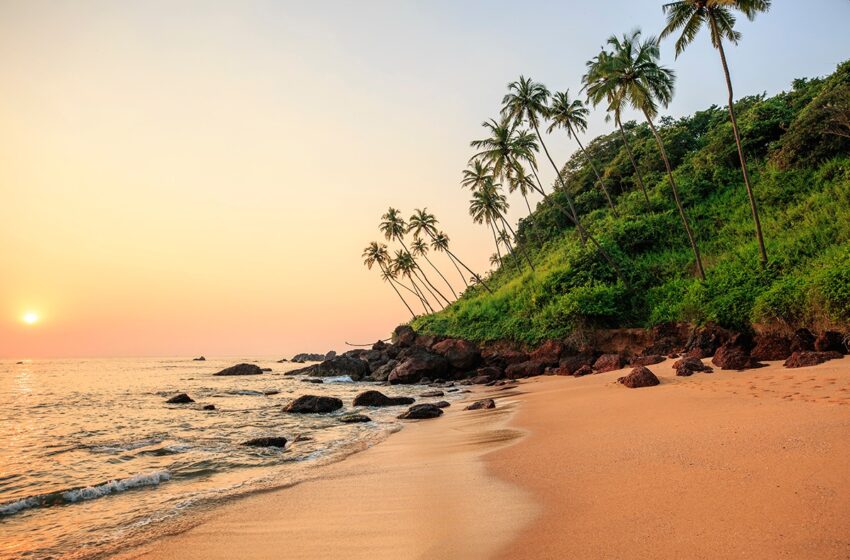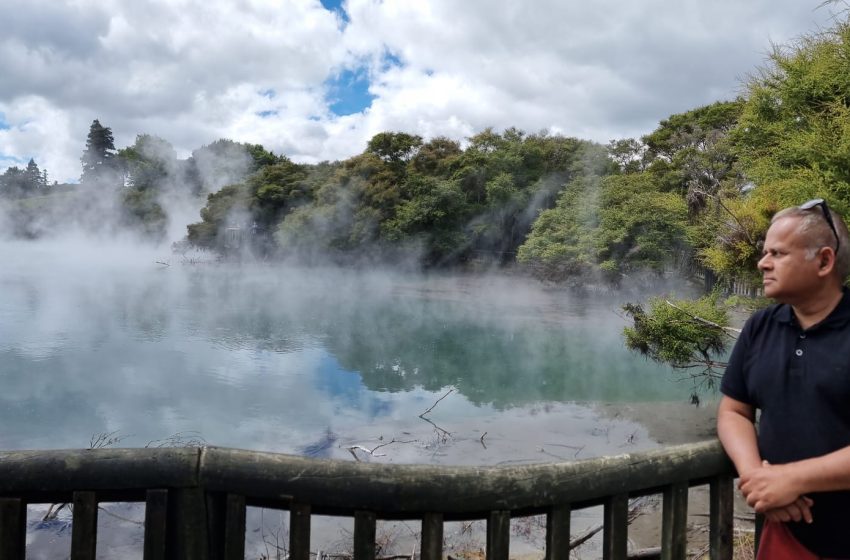By K. Siddhartha & Naleen Chandra

K. Siddhartha
In the kaleidoscope of India’s coastal destinations, Goa stands out as a unique gem, a tropical paradise that enchants the senses and leaves visitors yearning for more. With its pristine beaches, swaying palm groves, and vibrant culture, Goa exudes an allure that is simply irresistible.
Goa, officially the State of Goa, is a state in the western region of India, situated along the Arabian Sea coast. Its extensive history as a Portuguese colony until 1961 is reflected in the presence of well-preserved 17th-century churches and tropical spice plantations in the region. Goa is renowned for its picturesque beaches, encompassing both popular tourist destinations such as Baga and Palolem, as well as secluded beaches in tranquil fishing villages like Agonda.

Naleen Chandra
Whether you seek sun-kissed relaxation or adventurous exploration, Goa has something to offer every traveller. The soft sands of its beaches invite you to bask in the warm embrace of the sun or engage in thrilling water sports such as parasailing, jet skiing, and scuba diving. The crystal-clear waters reveal a mesmerizing underwater world, teeming with colorful marine life that will captivate any nature enthusiast.
Beyond the beaches, Goa’s lush green interior offers a verdant tapestry of natural beauty. Trek through the dense rainforests, where towering trees and melodious bird songs create a symphony of nature. Visit the breathtaking Dudhsagar Falls, where the milky white water cascades down in a majestic spectacle, leaving you in awe of its grandeur.
Goa, with its rich history and culture, offers stunning churches and temples with unique architectural styles. Its vibrant local festivals showcase music, dance, and traditional delicacies. The Goan cuisine, a blend of Indian and Portuguese flavours, tantalizes taste buds with tangy seafood, aromatic curries, and sweet desserts. Explore Goa’s enchanting beaches, lush landscapes, and vibrant culture to experience India’s coastal gem.
However, Goa tourism has recently seen some tough times with several incoming tourists, especially foreign tourists declining partly due to the COVID-19 era and partly due to ongoing wars and geopolitical disturbances.
In the realm of coastal destinations, Goa stands as a beacon of natural beauty and cultural richness. However, recent years have brought forth a series of challenges that have cast a shadow over the state’s tourism industry. The global COVID-19 pandemic, coupled with ongoing geopolitical conflicts, has significantly reduced the number of incoming tourists, particularly foreign visitors.
Goa, a land characterized by remarkable contrasts, stands out as a place where tangible and intangible heritage coexist harmoniously. Human endeavour and natural wonders blend seamlessly, creating a tapestry of sights and experiences that are unique to the region. Music and stillness intertwine, offering visitors an unparalleled opportunity to discover multiple worlds within a short period.
Situated between the Arabian Sea to the west and the towering Sahyadri mountains to the east, the Goan landscape ascends from sea level to an impressive height of 1022 meters. Numerous rivers traverse the state, enhancing its natural splendour. Goa’s diverse geographical features captivate tourists with their captivating blend of natural beauty and rich cultural heritage.
Goa’s geographical features provide a rich tapestry of experiences for tourists, allowing them to explore pristine beaches, discover hidden waterfalls, trek through dense forests, and immerse themselves in the state’s natural and cultural heritage.
Goa is renowned as a “sunshine state” due to its abundance of beaches, lively nightlife, and relaxed atmosphere, but there is much more to explore beyond these popular attractions. Many visitors are unaware of the diverse range of activities that this small state has to offer.
Goa provides a plethora of opportunities for adventure and recreation, including cycling tours, yoga classes, water sports, cooking lessons, spa treatments, Ayurvedic centres, surfing, snorkelling, water parks, snow parks, scuba diving, island excursions, fishing trips, casinos, yacht rentals, cycling, cruises, dolphin watching, photography, hiking, kayaking, waterfall visits, houseboats, bird watching, spice plantation tours, historical fort tours, wildlife sanctuaries, museums, churches, and temple visits. Each of these activities offers a unique and memorable experience.
With an exhaustive list of things to do in Goa, visitors are encouraged to explore and create unforgettable memories. They can cross off items from their bucket lists and discover the hidden gems that make Goa a truly versatile and captivating destination.
The emphasis on domestic tourism as a primary catalyst for tourism growth is centred around policies established at both the national and state levels specifically in the state of Goa.
Within the Indian subcontinent, Goa stands out as the sole state, after Kerala, wherein beaches occupy a central position in driving its tourism industry. Consequently, Goa has earned recognition as the predominant beach destination in India. By leveraging advancements in the hospitality sector and enhancing infrastructure, Goa possesses the potential to establish itself as a targeted international tourist destination, thereby elevating its stature to that of a globally renowned brand in the international tourism landscape.
Numerous international festivals, such as the esteemed International Film Festival of India, which has been held annually since last year, have elevated Goa to the status of an international epicentre in the realm of cinema. Nestled along the Malabar Coast, Goa is renowned for its Gothic churches, ancient forts, palm-fringed beaches, verdant coconut groves, picturesque ferry rides, and vibrant folk music. With its extensive coastline spanning 131 kilometres, Goa holds a significant place in the itineraries of tourists from India and around the world. The allure of sun, sand, and sea makes Goa an ideal haven for those seeking relaxation and tranquillity.
Goa, a popular tourist destination in India, has experienced fluctuations in the number of domestic and foreign tourist arrivals since 2018.
Here’s an overview of the trend:
 Domestic tourist arrivals showed a positive trend from 2018 to 2019 but faced a significant decline in 2020 due to the COVID-19 pandemic. However, domestic tourism gradually recovered in 2021 and 2022, although it has not yet reached pre-pandemic levels.
Domestic tourist arrivals showed a positive trend from 2018 to 2019 but faced a significant decline in 2020 due to the COVID-19 pandemic. However, domestic tourism gradually recovered in 2021 and 2022, although it has not yet reached pre-pandemic levels.
In contrast, foreign tourist arrivals witnessed a steady increase from 2018 to 2019 but experienced a dramatic drop in 2020 due to international travel restrictions imposed during the pandemic. The recovery of foreign tourism has been slower compared to domestic tourism, with arrivals remaining significantly lower than pre-pandemic levels.
It’s important to note that the COVID-19 pandemic has had a significant impact on tourism worldwide, and Goa’s tourism industry has not been immune to these challenges.
Earnings from Goa Tourism (2018-2022)
 Goa’s tourism industry has contributed significantly to the state’s economy. The total earnings from domestic and foreign tourists since 2018 are:
Goa’s tourism industry has contributed significantly to the state’s economy. The total earnings from domestic and foreign tourists since 2018 are:
It is important to note that the earnings for 2020 and 2021 were significantly impacted by the COVID-19 pandemic, which led to a sharp decline in tourist arrivals. However, the industry has shown signs of recovery in 2022, with earnings increasing in the first half of the year.
The tourism industry is a major source of employment in Goa, and it also contributes to the state’s GDP. The government of Goa is committed to promoting sustainable tourism and has taken several steps to attract both domestic and foreign tourists.
Seasonal Fluctuations in Tourist Arrivals in Goa
Goa’s tourism industry experiences significant seasonality, with the number of domestic and international tourists varying throughout the year. Here’s an overview of the trend:
Seasonality in Tourist Arrivals in Goa
 Goa receives around 14-17 million tourists annually, with the majority of arrivals occurring during the peak season.
Goa receives around 14-17 million tourists annually, with the majority of arrivals occurring during the peak season.
Goa’s tourism industry is highly seasonal, with the peak season running from November to February. During these months, the state experiences pleasant weather, making it an ideal destination for sunseekers and beach lovers. However, the off-season (March to October) sees a significant drop in tourist arrivals.
To address the issue of seasonality, the Goa government and tourism industry stakeholders have taken several steps like Product Diversification, Package Deals and Discounts, Events and Festivals, Infrastructure Development and Collaboration with Stakeholders
Efforts have been made to diversify Goa’s tourism offerings beyond sun and beach tourism. The state has been promoting its rich cultural heritage, adventure activities, and ecotourism destinations to attract tourists throughout the year.
Many hotels and tour operators offer special packages and discounts during the off-season to entice tourists. These incentives make Goa a more affordable destination for budget-conscious travellers.
The Goa government organizes various events and festivals throughout the year to keep the destination lively during the off-season. These events include music festivals, food festivals, and cultural events.
The government has invested in infrastructure development to improve accessibility and connectivity to various tourist destinations in Goa. This includes improving roads, public transportation, and airport facilities. Training programs and workshops are conducted for tourism stakeholders to enhance their skills and knowledge. This helps improve the overall quality of tourism services in Goa.
The Goa government works closely with tourism industry stakeholders, including hotels, tour operators, and travel agents, to develop and implement effective strategies for sustainable tourism development.
These steps have helped mitigate the impact of seasonality on Goa’s tourism industry and have contributed to the state’s overall tourism growth. By offering a diverse range of attractions and experiences, coupled with targeted marketing efforts and incentives, Goa has positioned itself as a destination that can be enjoyed throughout the year.
K. Siddhartha is an author of 48 books on Geology, Climate Change, Geopolitics, Space Technology, History and Geography.




 Domestic tourist arrivals showed a positive trend from 2018 to 2019 but faced a significant decline in 2020 due to the COVID-19 pandemic. However, domestic tourism gradually recovered in 2021 and 2022, although it has not yet reached pre-pandemic levels.
Domestic tourist arrivals showed a positive trend from 2018 to 2019 but faced a significant decline in 2020 due to the COVID-19 pandemic. However, domestic tourism gradually recovered in 2021 and 2022, although it has not yet reached pre-pandemic levels. Goa’s tourism industry has contributed significantly to the state’s economy. The total earnings from domestic and foreign tourists since 2018 are:
Goa’s tourism industry has contributed significantly to the state’s economy. The total earnings from domestic and foreign tourists since 2018 are: Goa receives around 14-17 million tourists annually, with the majority of arrivals occurring during the peak season.
Goa receives around 14-17 million tourists annually, with the majority of arrivals occurring during the peak season.



